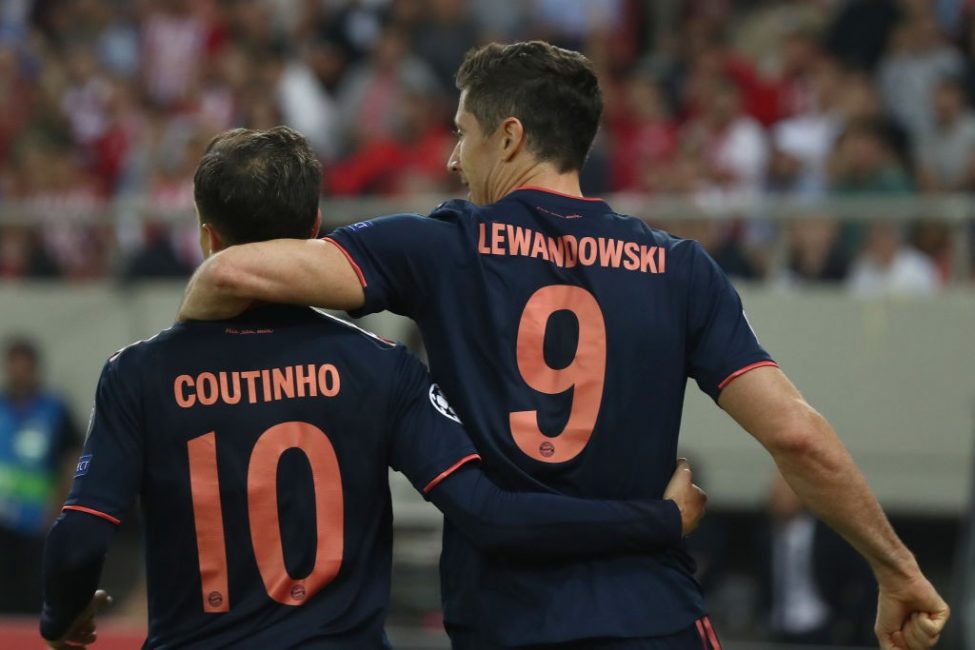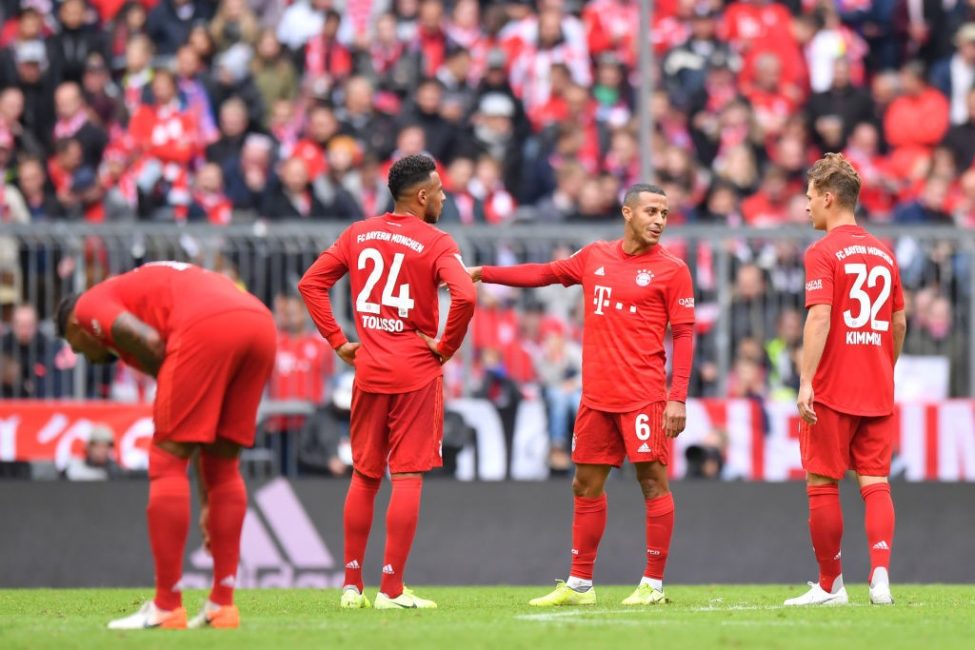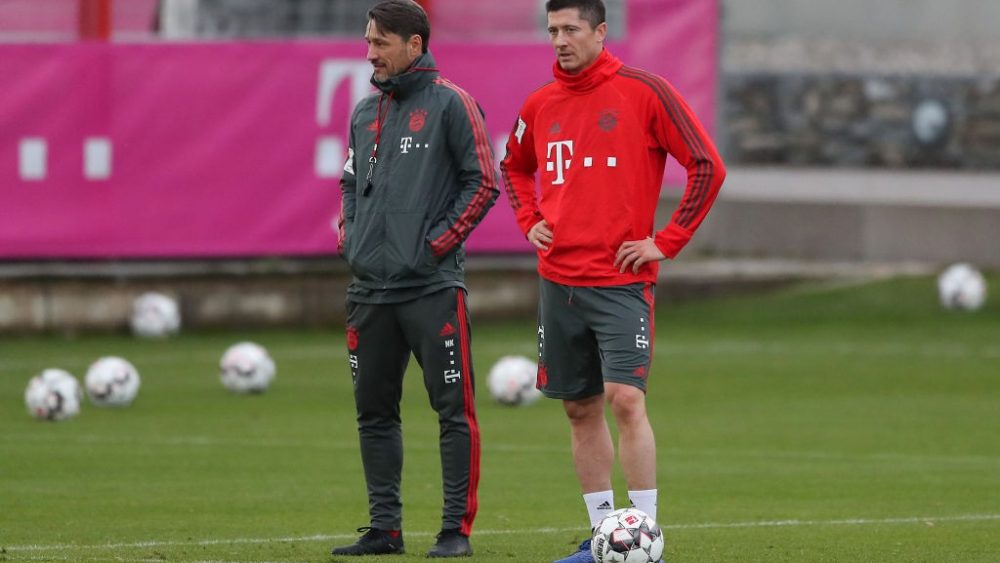My Five Cents: What is happening at Bayern at the moment?
This article was first published on our German site before the DFB Pokal game against VfL Bochum.
1. Out-of-this-world Lewandowski
Much has been said about Robert Lewandowski’s outstanding start to the season. We at Miasanrot could not stop singing his praises too and made him our player of the month of August and September – and he is very high on the list for October as well. In a sluggish Bayern team, Lewandowski is THE one reliably consistent performer and a safe harbor in a team that is otherwise constantly on the verge of shipwreck.
Yet Lewandowski’s stratospheric heights deserve a second look. The Polish striker scored in every single one of the season’s first thirteen matches apart from the Supercup. In doing so, he has broken Carsten Janker’s Club record of the year 2000. By scoring in all of the season’s first nine Bundesliga matches, he has also bettered the Bundesliga record previously held by Pierre-Emerick Aubameyang. Lewandowski himself had never scored in more than seven consecutive matches in his career before.
You want more? He has scored 37 goals in 2019 so far, four more than Messi and twice as many as Cristiano Ronaldo. That puts him in first place both for the calendar year and the 19/20 season. In the Champions League, he has just moved past Ruud van Nistelrooy to fifth place with 58 goals. In his club’s all time top scorer ranking, he is only eight goals short of second place Karl-Heinz Rummenigge at 218 goals. In 160 games fewer, mind you.
In my player of the month of September tribute I wrote that “the Polish striker will probably not be able to maintain his scoring rate in the coming weeks and months”. For the time being, I will have to retract this statement after just another month of free-flowing Lewandowski scoring lies behind us. There is just too much going right for him at the moment. Lewandowski will only be too aware of just how important his goals are to keep his team in title contention these days.
2. Coutinho or James? No matter. Any creative central playmaker will do.
Bayern’s signing of Philippe Coutinho gave the German media the opportunity to reprint the headlines they had previously used for the signing of James almost verbatim: struggling world star playing in la Liga joins FC Bayern on loan. Just like James Rodriguez in the summer of 2017, Philippe Coutinho joined Germany’s record champions having gone through a difficult spell in Spain’s first division. At Real Madrid, James never quite managed to continue playing at the level of performance that had brought him there after the 2014 World Cup. There were similar expectations tied to Philippe Coutinho’s €150m move to Barcelona from Liverpool, which the little magician from Brazil also failed to live up to at his new employer. The two are also very similar in their style of play. Both James and Coutinho are technical playmakers whose natural hunting ground is in central offensive midfield and who are very skilled with the ball at their feet.

(Image: Alexander Hassenstein/Bongarts/Getty Images)
Coutinho has been at Bayern for two months now. The season is in full flow, the first matches in Champions League and cup have been played. Time for us to take a look back and take stock of his role in this early phase of the season. Because the similarities between James and Coutinho do not end with the circumstances of their transfers, let us try to compare them as players too. Coutinho’s first weeks at Bayern seemed like the opening scenes to a wonderful fairytale. He appeared to settle in immediately, soon became a regular starter, and excited everyone with his pinpoint precision passes, his marvellous assists, and even the odd goal. His performance in the two matches against Cologne and Paderborn especially stands out. The media could not help starting to celebrate the – excuse me – Coup-inho.
But as is so often the case, after the heights of honeymoon the trials and tribulations of ordinary life await. All too often during recent weeks, Coutinho could not pick up where he left off in the season’s early games, despite Kovač making the permanent switch to a formation that has a dedicated spot for him in the central playmaker position. He did not make this concession to James. Instead, James frequently had to play in the number eight position, the defensive duties of which he often neglected.
In all of the season’s Bundesliga games so far, Coutinho has got an average of 1.9 key passes per game. James is ahead of him with an average of 2.8 and 2.6 key passes per game respectively in his two seasons at Bayern. But Coutinho has 0.5 more shots on goal than James (2.3 to 1.8) and 0.7 more successful dribbles per game (1.5 to 0.8). James was more involved in Bayern’s game and played significantly more passes per game in his time there than Coutinho does now (62 to 40). understat.com sees them head to head at expected goals (0.45 to 0.43), but James leads at expected assists (0.42 to 0.30). However, this might be due to Bayern’s playing style, which has been depending on individual player performances to a greater extent this year than in the past.
So what do the numbers tell us? Both these exceptional players are more different than one might think. Although Coutinho is given a more central role in the team (literally and figuratively), he creates fewer chances. He will have to make himself more available and demand more balls to be better able to set up and release his teammates in offense. However, James was an outstanding performer during his first year at Bayern and a cornerstone of his team. If Coutinho manages to improve by only a little, his statistics will be on a par with James’s.
3. A new defense is like a new lease of life
The 2-1 home win against Union was Bayern’s sixth successive competitive game where they conceded at least one goal. Bayern’s defense regularly seems to be at high sea this season. Even weaker opponents again and again manage to cut Bayern’s defense wide open by the simple expedient of a few quick passes.
Bayern let go of Hummels, perhaps last season’s best center-back, before the start of the season and signed Lucas Hernández and French World champion Benjamin Pavard to fill the vacancy Hummels had left in defense. But whatever degree of defensive stability Bayern had hoped to gain, it did not come. Bayern has kept a clean sheet only three times this season. There is a lack of continuity, precision, and stability – so in other words, of almost everything. And with both Süle and Hernández now out due to injury, Bayern is missing their entire central defense.

(Image: Christof Stache/AFP/Getty Images)
Because of a series of injuries, Bayern’s first defensive line consisting of Kimmich, Süle, Hernández, and Alaba have just played together three times this season, two of which Kimmich played in midfield. This is not suited to create any measure of routine in defense, where it is so crucially needed. In previous years, there always was a relatively stable combination of players in the back line, which allowed them to develop a blind understanding and gave them the confidence to defend without fear that any single mistake of theirs might become critical.
This fear is also partially reflected in the lack of precision in many defensive challenges. Bayern’s players have accumulated 18 yellow cards in only nine Bundesliga games so far. In most previous years, the count was 35-45 for the whole season. The current surge is a clear sign of players acting hesitantly and being late or not knowing how to help themselves to stop an opponent other than by resorting to a foul.
9.2 shots against per game is a considerably higher figure than last season’s 7.6. In terms of interceptions, the team also falls a little a bit short of last season’s standard. At the same time, Bayern has to make twice as many clearances, which serves to further reinforce the impression of deficient stability and high risk taking in defense.
4. The “Kovač out” scenarios
As soon as the 3-2 win against Paderborn, Kovač was on the verge of being sacked – in my Twitter timeline anyway. But is #kovacout actually a realistic scenario?
At least two problems come to mind immediately: first, there is the question as to who would see fit to make this decision at Bayern at the moment. Uli Hoeneß ist about to step down. This year’s annual general meeting (AGM) will be his last in front of his members. It is difficult to imagine that the outgoing president would release Kovač, who enjoys a certain rapport with the fans, in his last days in office. His successor Herbert Hainer will be very careful not to take such a big decision with such wide ranging implications in his first weeks in office. He will also most probably interpret his role as president of the club in stricter accordance with the club’s statutes than Hoeneß has done and get less involved in such operational decisions as the question of who is coach in general. This leaves Karl-Heinz Rummenigge. But the current CEO will also want to avoid causing unrest among club and supporters before the AGM and provide a turbulent welcome for new board member Oliver Kahn in January.
Second, there is no obvious candidate anywhere in sight who could follow Kovač. The selection on the national and international stage is currently rather frugal. Massimo Allegri, Arsene Wenger, and José Mourinho are the biggest names. The last two can be discarded out of hand because of their dominant personalities (mainly Mourinho) and expectation of having power and control at the club beyond their coaching duties (mainly Wenger).
Nevertheless, it seems likely that the club will want to hire an experienced coach after the end of the Kovač experiment. Yet should they again prefer a fresh talent to an old hand, names like that of Erik ten Hag and Mark van Bommel immediately spring to mind. Both have a Bayern background (one as a youth coach, the other as a player), but they would not be available before the end of the season at the earliest.
The intervening period would have to be covered by either temporarily promoting Hansi Flick or bringing in Jupp Heynckes once more. Both options do not appear terribly realistic at this point.
5. Two holding midfielders or two number eights = two blanks?
Last season, Kovač’s three men midfield almost exclusively consisted of one holding midfielder, mostly Thiago, behind two offensive midfielders (the number eights) in varying compositions. This season, Kovač has kept his three men midfield, but switched from one holding midfielder to two, and from two number eights to one central playmaker to accommodate Coutinho. Whereas Coutinho is a fixture in his position, Kovač has been struggling to find the ideal combination of players for the two spots in defensive midfield.
Kovač’s first choice after making the switch was that of the pair of Thiago and Kimmich. The two creative players harmonized well going forward and linked up well with Coutinho. Due to their tactical sophistication they were able to keep most of midfield covered in possession. Unfortunately, not before long Thiago started to add unexplainable unforced errors to his game with some regularity, which in many games earned him a starting place on the bench and gave Tolisso a chance.

(Image: Sebastian Widmann/Bongarts/Getty Images)
The Frenchman now often played alongside Thiago (rarely) and Kimmich (often). Regrettably, the introduction of Tolisso also introduced a deterioration of Bayern’s offensive structure. The old problem of large gaps and a lack of compactness in midfield swiftly reoccurred, because Tolisso tended to drift high and leave Kimmich alone in defensive midfield, which has been the source of several dangerous situations for Bayern already. Kimmich has not yet developed the same kind of calmness and unperturbed composure on the ball that is the hallmark of Thiago.
Kovač soon realized his team’s predicament and reacted by putting Javi Martinez next to Thiago in defensive midfield. Yet the Martinez of today is not the Martinez of the 2013 treble-heroes anymore. He has become dangerously susceptible to being overplayed or missing the right moment for a challenge in defense. When Bayern builds up from the back, he tends to drop back in between the center-backs to hide his shortcomings in build-up play. This leads to huge gaps and a disconnect between defense and offense. Often, Thiago has to double back to get the ball in a deeper position to initiate Bayern’s next attack, depriving Bayern’s offense of a crucial player to pass to.
Before the game against Union, Kovač reacted once more and brought on both of Coutinho and Müller, thus turning his previous switch to a two men defensive midfield on its head. This new setup still proved to be vulnerable in defense without remedying any of Bayern’s offensive issues. So the search for the perfect setup in midfield has still not come to an end.
One solution might be for Kovač to encourage his full-backs to shift inside more often during build-up. They could provide the requisite support to Thiago that allows Tolisso and the just returned Goretzka to execute their roles with greater freedom. In Kimmich, Alaba, Pavard and Hernández, there are enough sufficiently versatile defensive players in Bayern’s squad to make this work. All four of these are capable of moving inside in build-up play and defend in a shifted back three.
Finding the right recipe in midfield could be key for Kovač to recover Bayern’s lost dominance of ere. Whatever you hold against him, you cannot blame him for not trying. Now one of his plans has to come off.












Phillip Lahm would be a great manager….Pep called him “the smartest player he’d ever coached”